
Peter, Heloisa and Auke cruising Westwards around the globe with s/v Mundinho
Our position is updated regularly. Click on Current Position (right side) to find out where we are.
18 December 2012 | Shelter Bay Panama
28 November 2012
19 August 2012 | Panama city BYC
14 August 2012 | 7 34.734'N:78 11.947'W, Bahia Pina, Panama
04 August 2012 | 1 48.992'N:78 43.717'W, Tumaco - Colombia
29 July 2012 | 8 24.0264'N:79 04.9178'W, Isla Pedro Gonzalez - Archipel Las Perlas
23 July 2012 | Panama city
21 July 2012 | Colon, Panama
17 July 2012 | Colon, Panama
10 July 2012 | 9 35.228'N:78 52.950'W, Chichime
29 June 2012 | 9 35.346'N:78 40.542'W, Kalugir Tupu and Banedup
26 June 2012 | 9 35.191'N:78 44.751'W, Miriadiadup
24 June 2012 | 9 35.231'N:78 52.839'W, Uchutupu Pippi
21 June 2012 | 9 32.722'N:78 53.754'W, Cay Limon
15 June 2012 | Colon Panama
13 June 2012 | Shelter BAy, Colon Panama
11 June 2012
08 June 2012
06 June 2012 | Shelter Bay, Colon Panama
04 June 2012 | Shelter Bay, Colon Panama
Cruising the Panama Coast
12 May 2012 | Portobelo
Peter via Internet
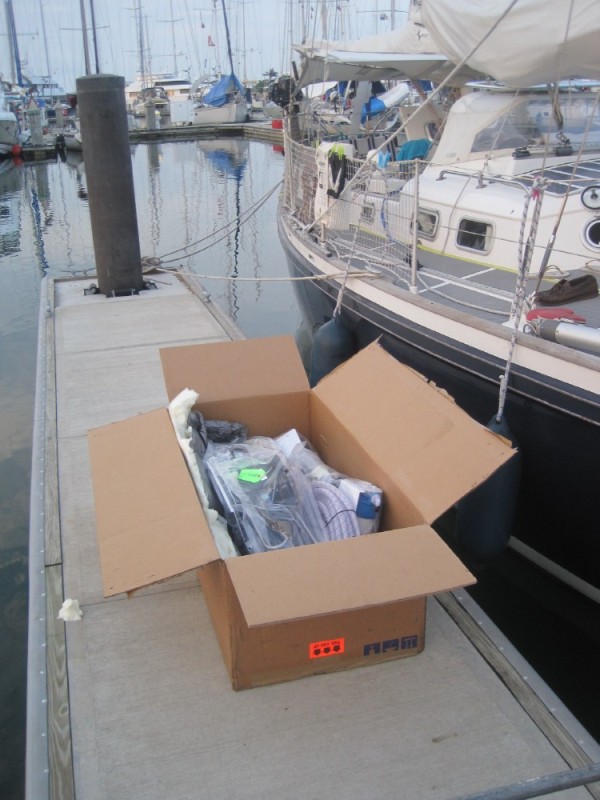
The Spectra Cape Horn watermaker arrived from the US in the Shelter bay marina on the 3rd. The large size of the box gave some immediate concern as to where possible this machine had to go, however after emptying the contents our concern was reduced. It should fit in the space we have in mind, currently holding toolboxes. We will have to find another space for the tool boxes which possible will require that either Auke or Heloisa has to stay home in the future, but anyway, that is the price to pay for having water making capability on board. The following morning I had to go downtown Colon, to the post office to collect a little package, containing a new led anchor light with photocell. Since the post office is right in the middle of muggers paradise I asked the taxi driver to wait for me outside. After 20 minutes inside the post office filling in documents and four windows further I finally had my little package in sight. I say in sight, there was only one problem according the final post office worker. The normally present customs was not present (pointing at an empty desk) and he would have to sign off on the package as it was "yacht in transit", meaning no import taxes where required to be paid. Well when would this custom official come? I have no idea he replied. So how are we going to solve this, as I need to go back to the boat and depart with the boat today I said. Again, no idea he said and raised his arms in the air, problemo... Can you call him I asked? Not possible. I have traveled and lived long enough in South America to know how to deal with this so here it went; Sir, to my knowledge there is a 10 USD fee for the collection of this package from customs (I am telling the post office worker). It might be a good idea that I pay you the 10 USD and you pay the customs official with that money once he comes into the post office. The Post office worker thought that was a great idea and handed me the package right away after which the 10 USD note disappeared into his trouser pocket.
We left the afternoon right after I got back in the marina. After 4 hours we dropped anchor the end of the day in Portbelo. Portbelo is located in beautiful surroundings and was the place where Columbus landed in his fourth exploration trip along the Central American coast, still convinced he was exploring the Asian coast and looking for a route into the Indian Ocean. (Columbus died in 1506 still convinced he had explored the East coast of Asia.) He also said the World was not round, but the shape of a pear. It all looks so unreal, funny now reading those comments, however once you cruise these coasts with the many islands, rocks and reefs bordering the coast line it is not difficult to understand that what they did was truly amazing. We navigate with the help of good charts, GPS (even DGPS in many locations nowadays), plotters and eyesight with excellent binoculars, and once a squall comes over (it is rainy season here now)
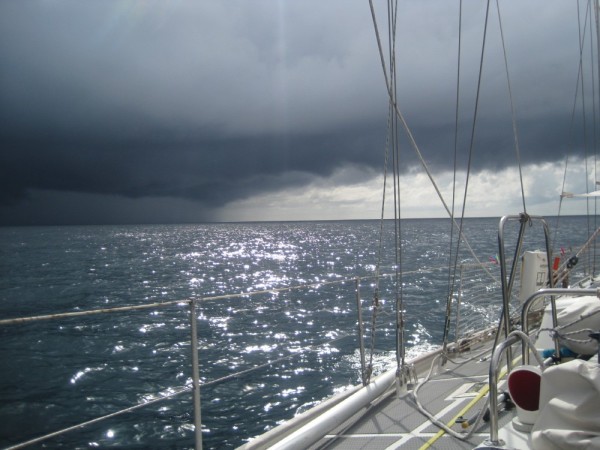
you switch on the radar which keeps you safely away from most dangers. Once the winds pick up you quickly pull in the reefs, drop the centerboard which allows you even when close hauled to make headway away from the coast into the winds if that would be required to stay clear. As you know that was all not available in 1503 to Christopher from Genoa. Most anchorages here provide shelter for winds from the East quarter. However the rainy season brings sudden West winds, at times fresh West winds. In those cases you have to work your way out of these anchorage, sometimes at night, which is relative easy for a modern yacht with the means described above. Even coming into bays with uncharted waters, your depth sounder, radar, eyesight on the bow and our trusty little engine makes things so much easier than trying to sail Christobal's Santa Maria, Pinta and Nina into the same bay 500 years ago.
How they did that with Columbus fleet is remarkable to me and often difficult to understand.
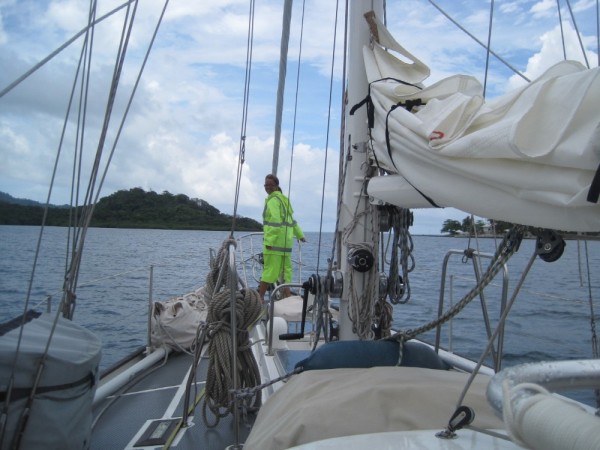
Anyway we dropped anchor in Portbelo. Portobelo became many years after Columbus discovery THE port where the Spaniards shipped their silver mined from the Potosi mines in Bolivia and the gold robbed from the Incas in Peru to the Spanish mainland, often via Cuba where it would be combined with the riches robbed from Mexico. To protect the gold and silver from the pirates several forts where built which some of them are still reasonable intact.

One fort was destroyed as they needed to large stones for the Panama Canal construction. The original custom building also still stands, here all the gold and silver passed through in order to count and document, the Spaniards where true burocrats, already in that time, painstakingly keeping track what was being shipped. The warehouses in Portobelo were at times so much stocked up with gold ornaments and gold bars that silver ingots where lying in the streets in front of the warehouses. Well that is the story at least.

Portobelo has always been a small village, despite it importance to the Spanish crown. The only time it was only busy was once a year during the fair, when the Spanish fleet would come in a sell their products and take all the Silver and Gold in return back to Spain, The Crown. (Many of it went directly to Genoa, as the Genoese bankers financed most of the Spanish enterprises such as wars and exploration trips).
Despite having the complete remains of a 300 year old fort in your backyard, the local inhabitants living behind the fort still need to do their dishes and laundry and get rid of their garbage. You do that naturally in the creek running behind the fort, already for 300 years. That is how it is in the third world and how we have seen it already so many times and you cannot even blame the locals living here. The Panamanian government, recently proudly announcing they want to elevate Panama to a first world country soon still has some way to go as even basic garbage collection is unheard of here (Outside Panama city). On Heloisa's question where the garbage bins were, or where we could deposit our garbage bag, locals without looking up answered just dump it in the river or burn it in the street.

After a few days we moved on down the coast, stopping in a variety of all beautiful anchorages. In most of them however the North East swell from the Caribbean finds its ways, which result in sometimes rolling to very rolling nights. Several times a day there is a rain shower coming over, some with wind, some not.
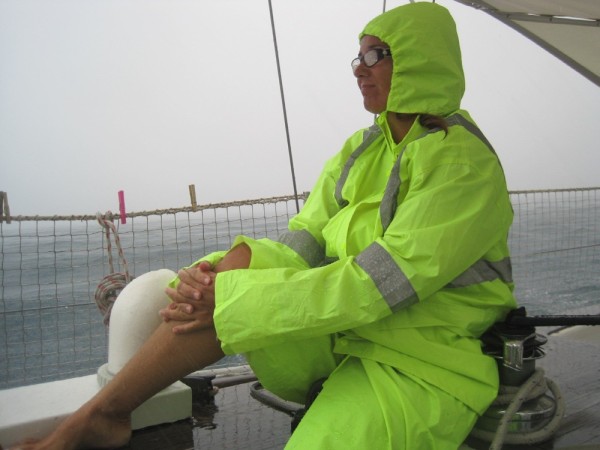
In most placed someone will come from the shore in a skiff with large outboard or in a simply dugout canoe to take your garbage and sell some fruit for a few USD.
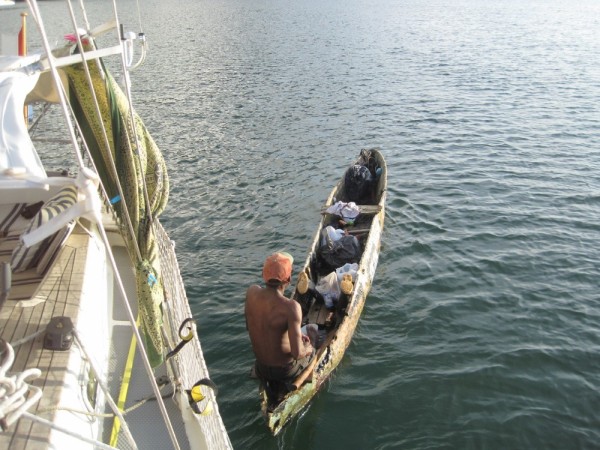
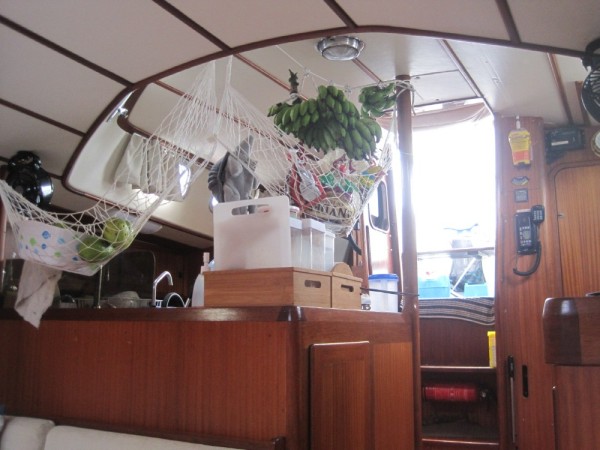
The rainy season which has started here brings regular rain showers, some just bring rain, some are full blown squalls bringing thunder and lighting, and lots of rain and lots of wind. When they bring wind, it is time to reef the sails. We are well set up for that so I do not mind that. It takes me alone typically only a few minutes to pull one or two reefs and I do not need to change course normally. I am still not pleased with the mainsail as I mentioned some time ago. The sail cut is great and provides a good drive for the boat. However once I reef the sail there is too much tension on the sail car directly above the reef point. This is a mistake from the sailmaker (UKHalsey) which has placed the sail slides in the wrong location (too close) to the reef points. So once you reef down, the first sail slide above the reef cringlet sees too much tension, risking tearing out the mainsail luff eyelets at that point. I had it changed on the first reef point, but it is still not good on the second and third reef point I noticed while in fresh winds. For now I can solve it by not placing too much tension on the leech clew while setting the second or third reef, however in a real blow I want to be able to flatten the sail, as otherwise you will only get more heel and more pressure on the rudder. I am thinking of replacing the current set up with a lined reefed from the sail to the sail cars in between the reef points. This should give a little more clearance but still hold the shape. For the mizzen it is not much of a problem, as in any fresh winds (above 20 knots apparent winds) we have the mizzen sail already down as it does not add to the speed at that point and only bring more lee-helm. I would like to consult a sailmaker about this option, but I have not found a good one yet here in Panama.
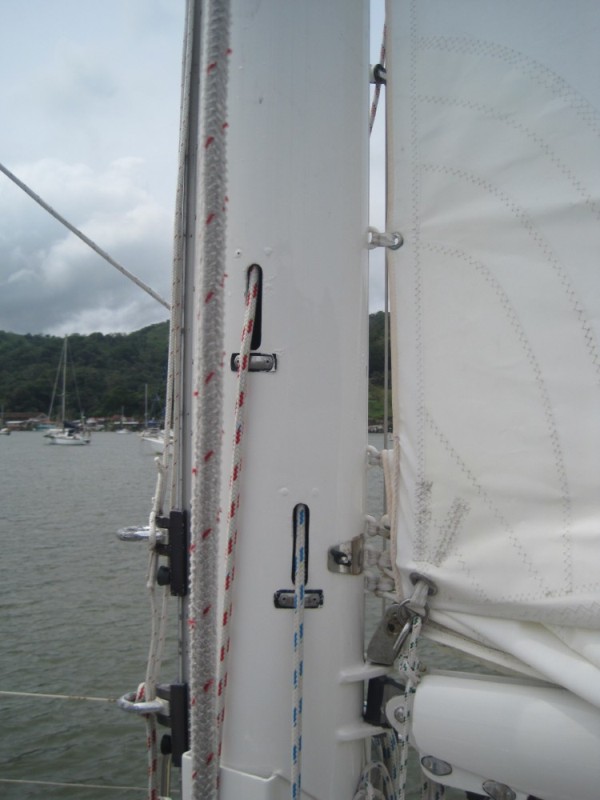
The rainy season also brings some more time on board for Auke. During rainy spells he is confined to the cabin which then slowly turns into a mess, or really it turns into a "kids cave". We do not like it too much, however what can you tell a 7 year old locked up in a 42 ft boat during rainy days.

Heloisa and myself stick on those rainy moments to our books and play games with Auke. It is cozy and nice, but can at times be sticky hot, as you have to close hatches and portholes etc. for the rain. Those times I make a great coffee in my favorite coffeemaker. It is the best coffee man has ever produced I believe. The coffeemaker came with the boat and we had never used it, till a few months ago I was so fed up with instant coffee that I gave it a go. I did not even know how to use it. But now I am a full professional coffee maker. The coffee is the best I believe, although Heloisa is not convinced in my coffee making capability. The importance is in the course of the coffee and naturally where the coffee comes from. I have now tried Cuban coffee, Jamaican coffee and am trying Panamanian coffee right now. When I sailed the boat from Houston to Key West in October last year with my father, we were always both complaining about the coffee. Being both true coffee drinkers, we always complained that the instant coffee gave the necessary caffeine shot, but lacked the great taste. Well now I got it all figured out. Alias, I am going to make myself a fresh coffee right now.
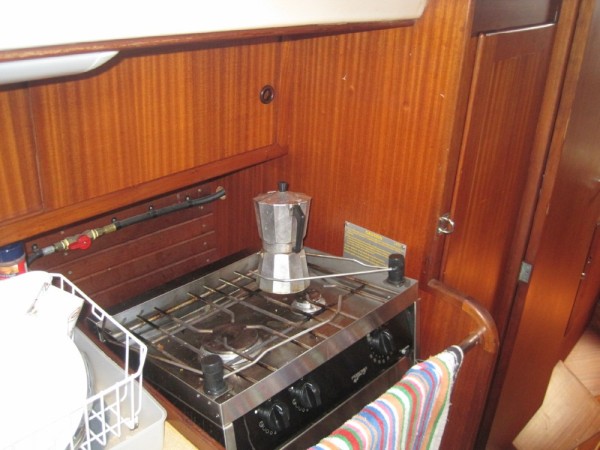
We are back in Portobelo since this morning. In two days we head back to Shelter Bay marina in Colon Panama, where I will depart for Holland with Auke to visit my parents for a week before we head into the Pacific and further. For them to see me is nice, but not detrimental. They go for their grandson, Auke and are looking forward for a week spoiling this boy. Auke knows that very well and as such on his side is very much looking forward to his trip. Heloisa will stay on the boat in the marina. She will upon our return travel to Brasil with Auke to visit her mother. Financially this worked best for us instead of all of us flying to both Holland and Brasil and also once Heloisa is in Brasil with Auke it will give me 2 weeks of space and time to install the new water maker and replace a crankshaft seal on the engine, for which I need to pull the engine out. Thanks to the design of this boat, pulling an engine out is rather easy to do with the large bolted hatch right over the engine located under the small center cockpit. The engine is leaking oil over the crankshaft seal. Not too bad yet, however I do not want to wait till Tahiti or New Zealand, as once the crankshaft seal fully blows you are unable to run the engine and some type of emergency repair is not possible with these seals.
For now we enjoy the sunsets while happily at anchor. The sunsets get often quite dramatic with all these rainclouds around.
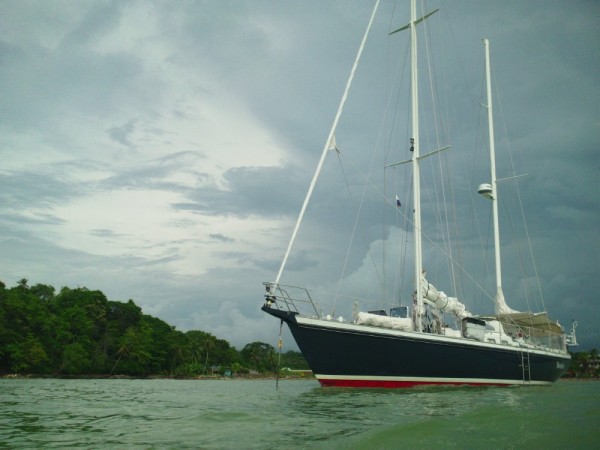
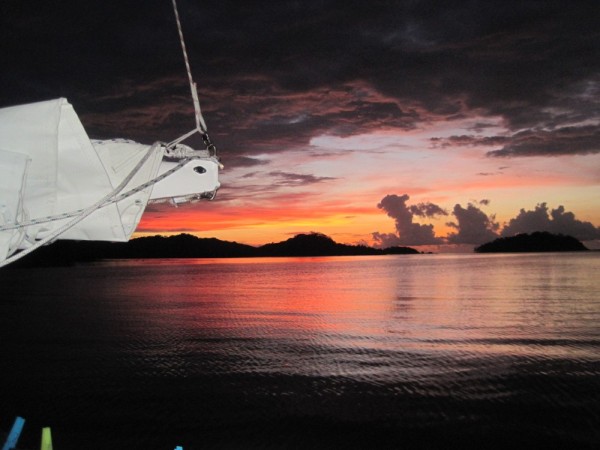
Comments
| Vessel Name: | Mundinho |
| Vessel Make/Model: | Koopmans 42 - Ketch - Alu Centerboard |
| Hailing Port: | Harlingen - Holland |
| Crew: | Peter, Heloisa and Auke |
| About: | We are a family of three, a rather international get together with myself being Dutch, my lovely wife being Brazilian and our 7 year old son who carries a Dutch and Brazilian citizenship |
| Extra: | You can follow us here during our two year sailing trip that will take us together via the Caribbean and the Islands in the Pacific to New Zealand. Beyond that I will take Mundinho to Europe solo. |
| Home Page: | www.sv-mundinho.com |
Gallery not available
Family of three travelling West Bound (slowly)
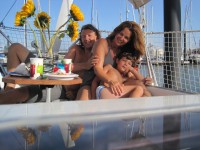
Who: Peter, Heloisa and Auke
Port: Harlingen - Holland
All Blogs posted
Peter and Heloisa and their 7 year old son Auke are traveling with their sailing vessel a Koopmans 42. On this blog you can find updates regularly posted of their preparation and trip itself. Feel free to leave a message or raise a question if you have any for Peter and Heloisa.